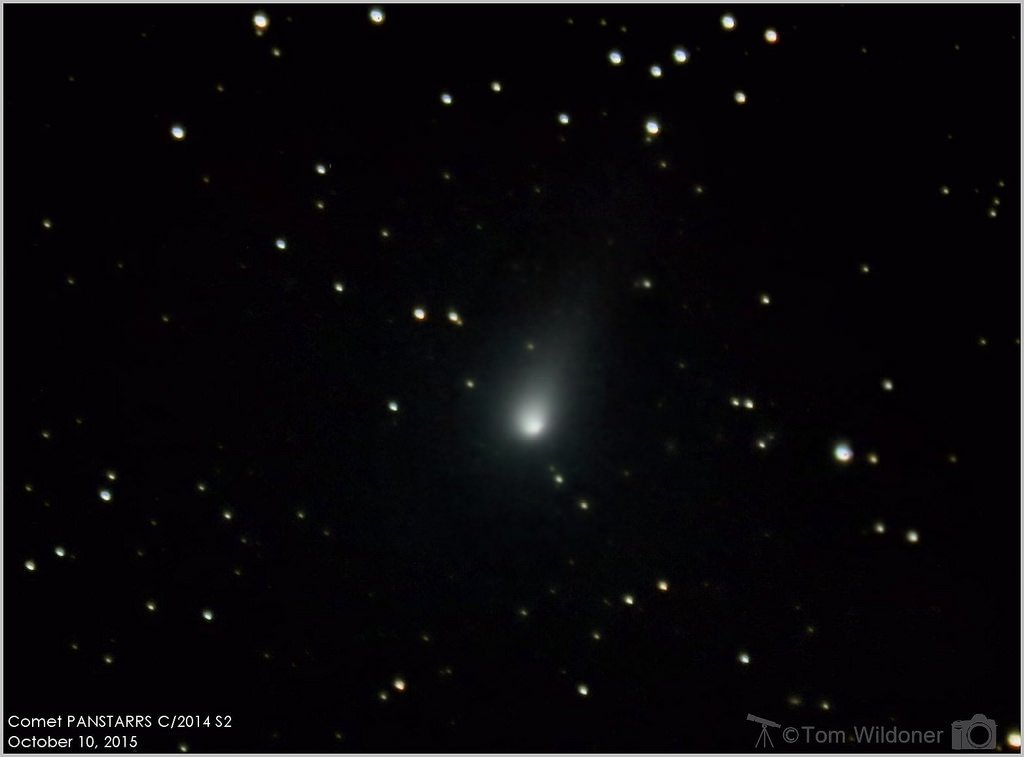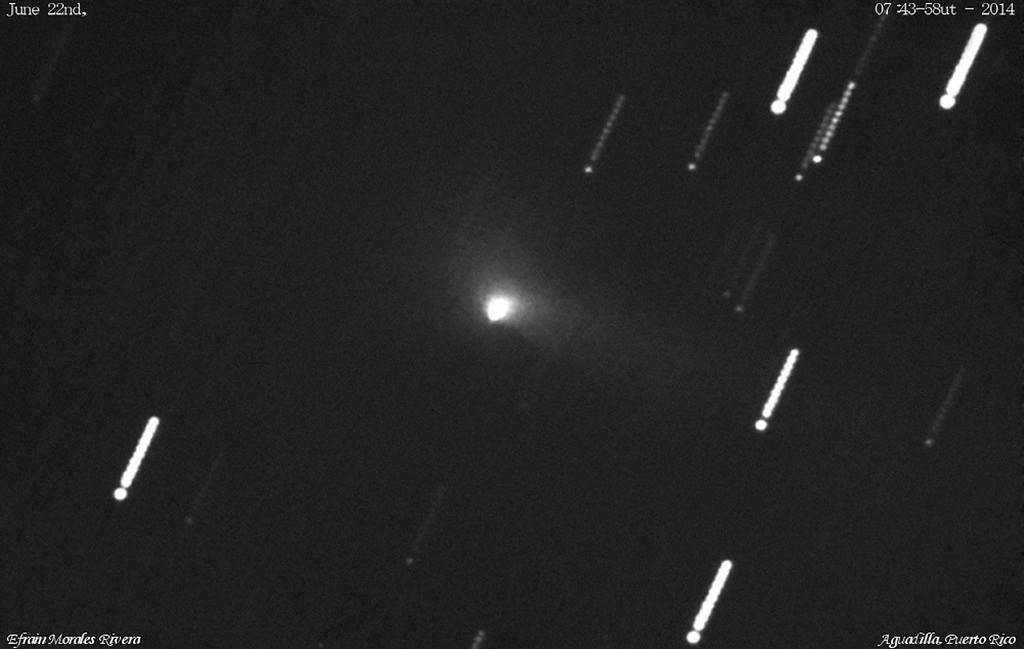Now is the time to catch binocular Comet C/2014 S2 PanSTARRS, as it tops +8 magnitude ahead of predictions this month and crosses circumpolar northern skies. Will this Christmas comet stay bright post-perihelion, rivaling other comets into early 2016? Continue reading “Catch This Season’s ‘Other’ Comet: S2 PanSTARRS”
Comet US10 Catalina: Our Guide to Act II
Itching for some cometary action? After a fine winter’s performance from Comet C/2014 Q2 Lovejoy, 2015 has seen a dearth of good northern hemisphere comets. That’s about to change, however, as Comet C/2013 US10 Catalina joins the planetary lineup currently gracing the dawn sky in early November. Currently located in the constellation Centaurus and shining at magnitude +6, Comet US10 Catalina has already put on a fine show for southern hemisphere observers over the last few months during Act I.
Currently buried in the dusk sky, Comet US10 Catalina is bashful right now, as it shares nearly the same right ascension with the Sun over the next few weeks, passing just eight degrees from our nearest star as seen from our Earthly vantage point on November 7th — and perhaps passing juuusst inside of the field of view for SOHO’s LASCO C3 camera — and into the dawn sky.
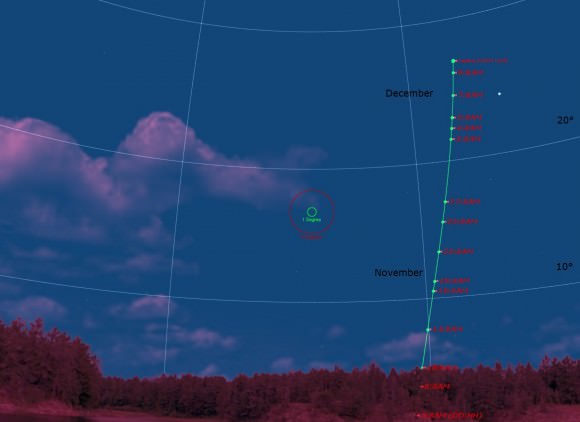
The hunt is on come early November, as Comet US 10 Catalina vaults into the dawn sky. From 30 degrees north latitude here in Central Florida, the comet breaks 10 degrees elevation an hour prior to local sunrise right around November 20th. This should see the comet peaking in brightness right around magnitude +5 near perihelion the same week on November 16th.
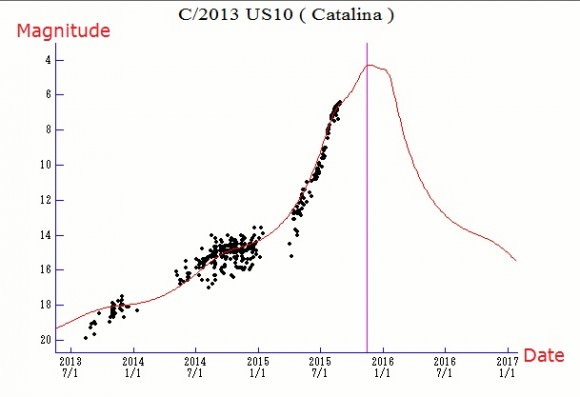
The angle of the comet’s orbit is favorable for northern hemisphere viewers in mid-November, as viewers start getting good looks in the early morning from latitude 30 degrees northward and the comet gains about a degree of elevation per day. This will bring it up out of the murk of twilight and into binocular view.
Mark your calendar for the morning of December 7th, as the crescent Moon, Venus and a (hopefully!) +5 magnitude comet US10 Catalina will all fit within a five degree circle.
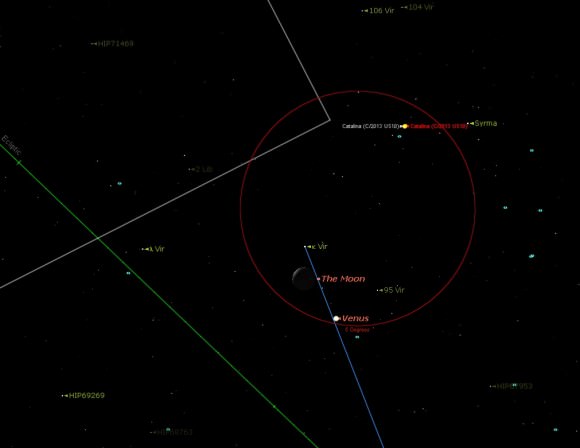
Here are some key dates with celestial destiny for Comet US10 Catalina for the remainder of 2015:
October
20-Crosses into the constellation Hydra.
November
2-Crosses into the constellation Libra.
16-Crosses into the constellation Virgo.
16-Reaches perihelion at 0.823 AU (127.6 million kilometers) from Sun.
26-Crosses the ecliptic plane northward.
27-Passes less than one degree from the +4.5 magnitude star Lambda Virginis.
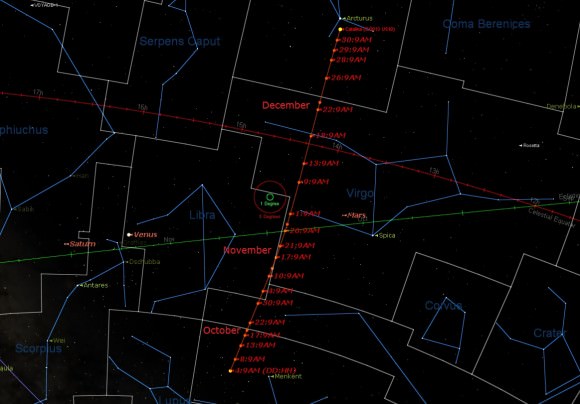
December
7-Fits inside a five degree circle with Venus and the waning crescent Moon.
8-Passes less than one degree from the +4 magnitude star Syrma (Iota Virginis).
17-Crosses the celestial equator northward.
24-Crosses into the constellation Boötes.
In January, Comet US10 Catalina starts the New Year passing less than a degree from the -0.05 magnitude star Arcturus. From there, the comet may drop below +6 magnitude and naked eye visibility by mid-month, just prior to its closest approach to the Earth at 0.725 AU (112.3 million kilometers) on January 17th. By February 1st, the comet may drop below +10th magnitude and binocular visibility, into the sole visual domain of large light bucket telescopes under dark skies.
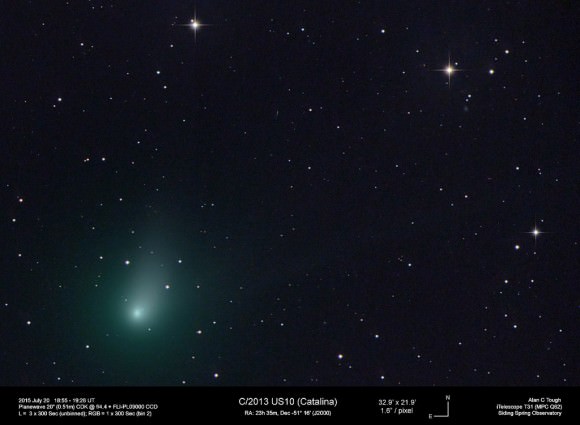
Or not. Comets and predictions of comet brightness are always notoriously fickle, and rely mainly on just how the comet performs near perihelion. Then there’s twilight extinction to contend with, and the fact that the precious magnitude of the comet is diffused over its extended surface area, often causing the comet to appear fainter visually than the quoted magnitude.
But do not despair. Comets frequently under-perform pre-perihelion passage, only to put on brilliant shows after. Astronomers discovered Comet US10 Catalina on Halloween 2013 from the Catalina Sky Survey based just outside of Tucson, Arizona. On a several million year orbit, all indications are that Comet US10 Catalina is a dynamically new Oort Cloud visitor and will probably get ejected from the solar system after this all-too brief fling with the Sun. Its max velocity at perihelion will be 46.4 kilometers per second, three times faster than the New Horizons spacecraft currently on an escape trajectory out of the solar system.
The odd ‘US10’ designation comes from the comet’s initial identification as an asteroidal object, later upgraded to cometary status. The comet’s high orbital inclination of 149 degrees assured two separate showings, as the comet approached the Sun as seen from the Earth’s southern hemisphere, only to then vault up over the northern hemisphere post-perihelion. As is often the case, the comet was closest to the Sun at exactly the wrong time: had perihelion occurred around May, the comet would’ve passed the Earth just 0.17 AU (15.8 million miles or 26.3 million kilometers) distant! That might’ve placed the comet in the negative magnitudes and perhaps earned it the title of ‘the Great Comet of 2015…’
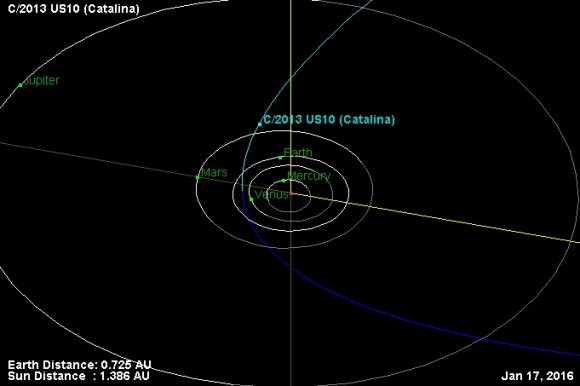
But such was not to be.
Ah, but the next ‘big one’ could come at any time. In 2016, we’re tracking comet C/2013 X1 PanSTARRS, which will ‘perhaps’ become a fine binocular comet next summer…
More to come. Perhaps we’ll draft up an Act III for US10 Catalina in early January if it’s a top performer.
Comet C/2013 US10 Catalina: A Preview for Act I
Live in (or planning on visiting) the southern hemisphere soon? A first time visitor to the inner solar system is ready to put on the first of a two part act starting this month, as Comet C/2013 US10 Catalina breaks +10th magnitude and crosses southern hemisphere skies.
Though we’ve overdue for a this generation’s ‘great comet,’ we’ve had a steady stream of fine binocular comets in 2015, including 2014 Q2 Lovejoy, 2014 Q1 PanSTARRS, and 2015 G2 MASTER. US10 Catalina looks to follow this trend, topping out at just above naked eye visibility in late 2015 going into early 2016.
Discovered by the Catalina Sky Survey on Halloween 2013, the comet received its unusual ‘US10’ designation as it was initially thought to be an asteroid early on in a periodic six year orbit, until a longer observation arc was completed. This is not an unusual situation, as new objects are often lost in the Sun’s glare before their orbit can be refined.

We now know that US10 Catalina is on a million year long journey from the distant Oort Cloud. Most likely, it was disturbed by an unrecorded close stellar passage long ago. We say that such comets are dynamically new, and this passage will eject US10 Catalina from the solar system. The comet also has a highly inclined orbit tilted almost 149 degrees relative to the ecliptic, and was at +19th magnitude and 7.7 AU from the Earth when it was discovered, suggesting an intrinsically bright comet.
Prospects for US10 Catalina currently favor latitude 35 degrees north southward in late June, though that’ll change radically as the comet makes the plunge south this summer. As of this writing, US10 Catalina was at +11 magnitude ‘with a bullet’ and currently sits in the constellation Sculptor at a declination -30 degrees in the southern sky.
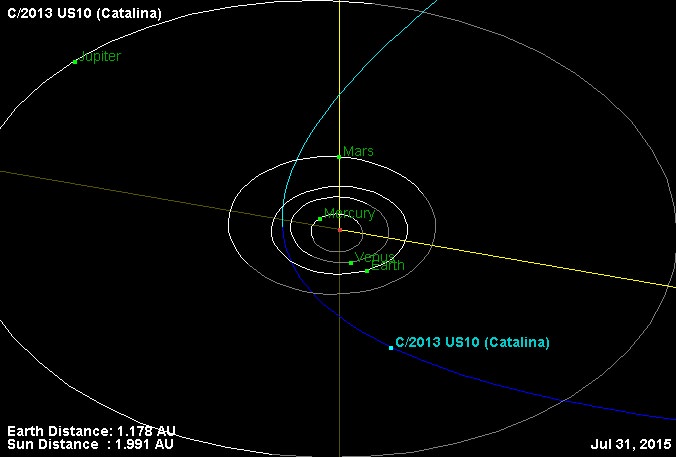
Binoculars are our favorite tools for observing comets, as they’ve easy to sweep the skies with on our cometary quest. As with nebulae and deep sky objects, keep in mind that quoted magnitude for a comet is spread out over its apparent surface area, causing them to appear fainter than a star of the same magnitude.
Here’s a blow-by-blow for Act I for Comet C/2013 US10 Catalina over the next few months:
(Unless otherwise noted, we documented stellar passages below that are within 2 degrees of stars brighter than +5th magnitude, and fine NGC deep sky objects brighter than +8th magnitude)
July 1st: May break binocular visibility, at +10th magnitude.
July 6th: Crosses into the constellation of Phoenix.
July 23rd: Crosses into the constellation Grus.
July 25th: Crosses into the constellation Tucana.
July 26th: Passes the +4th magnitude star Gamma Tucanae.
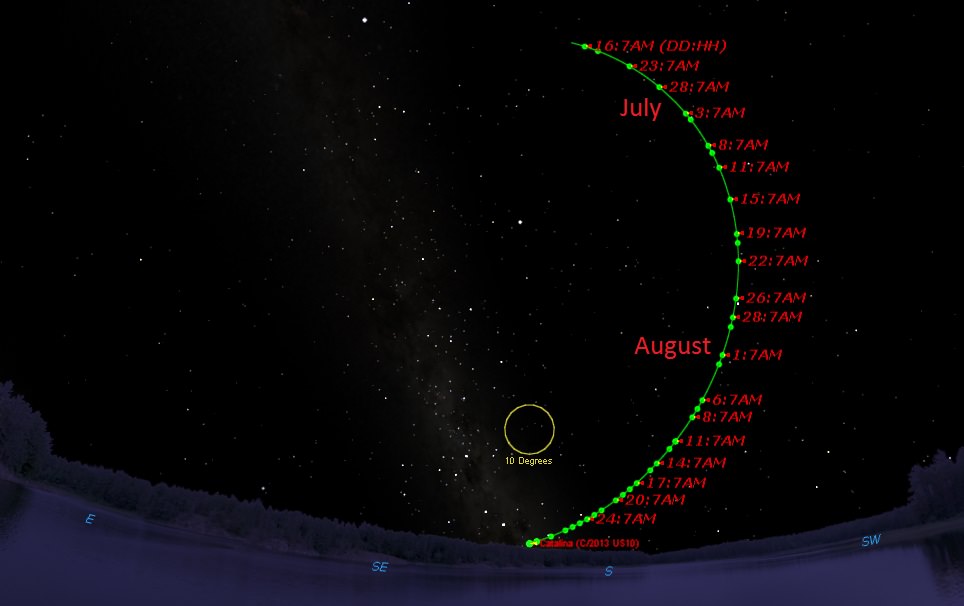
August 1st: Reaches opposition.
August 2nd: Passes the +4.5th magnitude star Delta Tucanae.
August 4th: Crosses into the constellation Indus.
August 6th: Photo op: Passes 12 degrees from 47 Tucanae and the Small Magellanic Cloud.
August 8th: Crosses into the constellation Pavo.
August 12th: Passes the +4th magnitude star Epsilon Pavonis.
August 14th: Reaches its greatest declination south at almost -74 degrees.
August 15th: Sits at 1.1 AU from the Earth.
August 17th: Crosses into the constellation Apus.
August 19th: Passes 5 degrees from the +7.7 magnitude globular cluster NGC 6362.
August 22nd: Crosses into the constellation Triangulum Australe and passes the +1.9 magnitude star Atria.
August 28th: Passes the +2.8 magnitude star Beta Trianguli Australis.
August 29th: Passes 3 degrees from the +5th magnitude open cluster NGC 6025.
September 1st: Crosses into the constellation Circinus
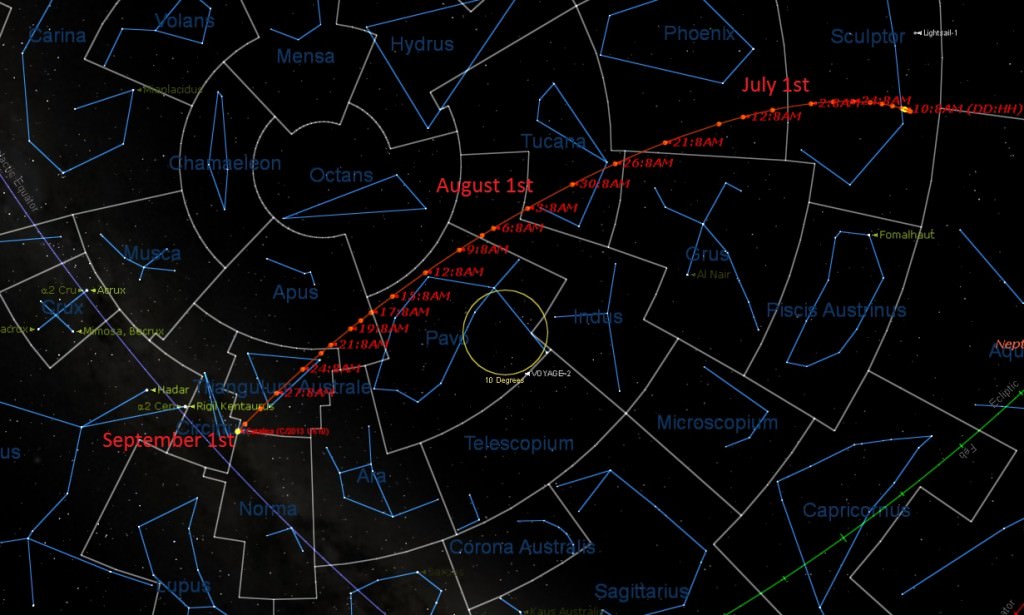
From there, Comet US10 Catalina heads towards perihelion 0.8229 astronomical units from the Sun on November 15th, before vaulting up into the northern hemisphere sky in the early dawn. Like Comet Q2 Lovejoy last winter, US10 Catalina should top out at around +4th magnitude or so as it glides across the constellation Ursa Major just after New Years.
And like many comets, the discriminating factor between a ‘great’ and ‘binocular comet’ this time around is simply a matter of orbital geometry. Had C/2013 US10 Catalina arrived at perihelion in the May time frame, it would’ve passed less than 0.2 AU (30 million kilometres) from the Earth!
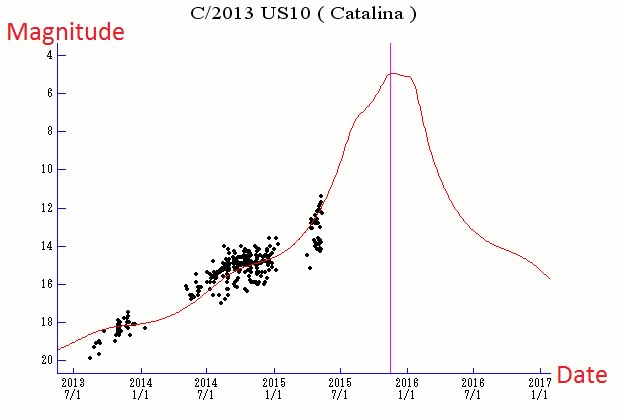
But that’s cosmic irony for you. Keep in mind, with Comet US10 Catalina being a dynamically new first time visitor to the inner solar system, it may well up brighten ahead of expectations.
And there’s more to come… watch for Act II as we follow the continuing adventures of Comet C/2013 US10 Catalina this coming September!

